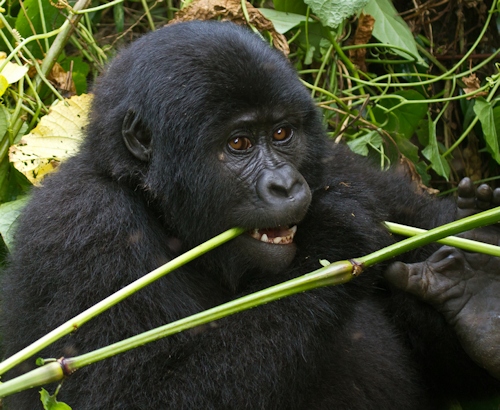Bwindi Impenetrable National Park
Home | Safaris | blog |
parks

Following a call of conservation and protection of wildlife in Uganda, one of the most famous destinations in the world; Bwindi impenetrable forest national park was designated and now offers asylum to over 400 unique endangered mountain Gorillas in the world, about 120 mammals, and over 350 bird species in four of her sectors. It was confirmed as UNESCO natural world Heritage site in 1994, after attaining the status as a national park in 1991; one of the newest conservation areas in the country. The park sits on a 321kms ha, at an altitude of 1,160m-2,607m above sea level.
The Bwindi impenetrable national park is located around the giant Volcano Mountains that sprawls through three countries; Uganda, Rwanda, and the democratic republic of Congo. The park seats on three districts in the southwestern part of Uganda; kanungu, kisoro, and Kabale on the edge of the magnificent rift valley.
Bwindi impenetrable forest is one true Jungle in Africa; one of the oldest montane forests in Uganda, dating back to over 20,000 years, with over 400 unique tree species. Other unique species harbored in this Jungle include; over 1,000 flowering plants, 350 bird species, 28frog species, primates such as the chimpanzees, Columbus monkeys, and geckos, and reptiles such as chameleons among others.
The transformation of Bwindi Forest into a conservation area and the national park started in 1932, when there were two blocks of the forest turned into a crown forest reserves. the southern block named "Kasatora crown forest reserve" and the northern reserve named "Kayonza crown forest reserve", occupying a combined land area of approximately 207km2. in 1942, the two blocks were made one, expanded, and renamed Impenetrable central crown forest reserve, under the management of Uganda governments game and forest departments.
Forward to 1964, the area was made an animal sanctuary, to protect the endangered mountain gorillas. This name remained in place up to 1966 when it was expanded to about 321sqkm2 and renamed the impenetrable central forest reserve. in 1991, the light showed bright as the reserve was renamed Bwindi impenetrable national park and declared a national park; alongside Mgahinga Gorilla reserve and the Rwenzori mountain reserve. However, on the contrary, the designation of the park also led to the displacement of the Batwa pygmies who lived in the forest as gatherers and wonderers. From 1993, the park became a famous tourist destination globally, with Gorilla trekking as the main activity. The Mubare group in the Buhoma sector was the first family to be tracked by tourists in 1993.
There are currently over 17 habituated gorilla families in the four sectors of Bwindi impenetrable national park; Buhoma, Ruhija, Nkuringo and Rushaga; under the management of Uganda wildlife authority, and located in the three districts of Kisoro, Kanungu, and Kabale.
This is the oldest and most visited sectors in the park. It was the first to receive visitors in 1993. The Buhoma sector is situated in the northern part of the park, accessible through Kahiihi and kabala airstrip. There are only 4 Gorilla groups in this sector open for tracking notably; Mubare group, Katwe family, Habinyanja family and Rushegura.
Rushaga sector
Rushaga is one of the most exciting Gorilla trekking regions, situated in the southern part of the park. It is also an area where most of the Gorilla families are habituated notably; Nshongi, Bweza, Busingye family, Kahungye and Mishaya families.
Nkuringo sector
With two gorilla families open for trekking, Nkuringo is a unique sector and requires trekkers to be physically feet because it is at a high altitude place. It seats in the east direction with three families namely Christmas, Bushabo and Nkuringo families.
Ruhija sector
This is the coldest region of Bwindi, positioned at approximately 2350m above sea level. It is one sector not to miss out. Some of the families here include; Oruzogo, Kyaguriro A & B and Bitukura families among others.
Gorilla trekking is the main activity in the park, with eight people aged 15 and above permitted to track a gorilla group per day. It starts at approximately 08:00hours for over 5 hours depending on one's speed and pace. The permits are at 700usd per day per person, exclusive of accommodation and other services.
Other activitivities in and around the park include a cultural encounter with the Batwa pygmies; former wonderers and gatherers in the Bwindi forest, believed to be the shortest people in Uganda, birding, gorilla habituation, canoeing at Lake Bunyonyi and hiking activities among others.
When to visit Bwindi forest for gorilla trekking?
As you may wonder the best time to travel for a safari to Bwindi impenetrable national park; Dry season; June to October and December to February are the best months. However, any other time can work, as long as you have the time and money.
Here are a few things you need to carry as you head out for a safari in Bwindi; a valid gorilla trekking permit, camera, strong hiking boots, garden gloves, long-sleeved shirts, trousers, insecticides, binoculars, long stockings, Visa, passport, Covid19 negative test form and other personal effects.
Where to stay in Bwindi forest?
Accommodations here range from budget to luxury, with classic services, security / safety, accessibility, food, staff and cleanliness among others. They are located in the different sectors and as such Gorilla trackers are advised to book in different sectors they are to track from.
Bwindi impenetrable national park is one of the most rewarding destinations in Africa, famous for its biodiversity and residents (the endangered mountain gorillas).
It has excellent security, very accessible, and plenty of unique flora and fauna in the wild. A 3 days’ gorilla safari is one of the most ideal ways to explore this Jungle and discovering what is hidden from the world.









